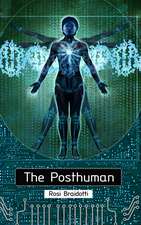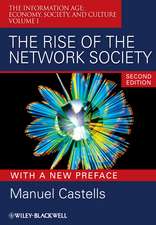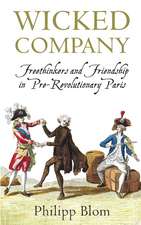Kinesthetic Empathy in Creative and Cultural Practices
Editat de Dee Reynolds, Matthew Reasonen Limba Engleză Paperback – 14 iul 2012
A key interdisciplinary concept in our understanding of social interaction across creative and cultural practices, kinesthetic empathy describes the ability to experience empathy merely by observing the movements of another human being. Encouraging readers to sidestep the methodological and disciplinary boundaries associated with the arts and sciences, Kinesthetic Empathy in Creative and Cultural Practices offers innovative and critical perspectives on topics ranging from art to sport, film to physical therapy.
Preț: 303.00 lei
Nou
Puncte Express: 455
Preț estimativ în valută:
57.98€ • 61.100$ • 48.34£
57.98€ • 61.100$ • 48.34£
Carte disponibilă
Livrare economică 27 martie-10 aprilie
Livrare express 13-19 martie pentru 42.37 lei
Preluare comenzi: 021 569.72.76
Specificații
ISBN-13: 9781841504919
ISBN-10: 1841504912
Pagini: 334
Ilustrații: halftones throughout
Dimensiuni: 178 x 229 x 20 mm
Greutate: 0.62 kg
Editura: Intellect Ltd
Colecția Intellect Ltd
ISBN-10: 1841504912
Pagini: 334
Ilustrații: halftones throughout
Dimensiuni: 178 x 229 x 20 mm
Greutate: 0.62 kg
Editura: Intellect Ltd
Colecția Intellect Ltd
Notă biografică
Matthew Reason is a senior lecturer in theater and the head of MA Studies in Creative Practice at York St John University in England. He is the author of, most recently, The Young Audience: Exploring and Enhancing Children’s Experience of Theatre. Dee Reynolds is professor of French at the University of Manchester and the author of, among other books, Rhythmic Subjects: Uses of Energy in the Dances of Mary Wigman, Martha Graham and Merce Cunningham.
Cuprins
Acknowledgements
Foreword
Amelia Jones
Introduction
Dee Reynolds and Matthew Reason
Part I: Mirroring Movements: Empathy and Social Interactions
Introduction
Dee Reynolds
1. Knowing Me, Knowing You: Autism, Kinesthetic Empathy and Applied Performance
Nicola Shaughnessy
2. Kinesthetic Empathy and Movement Metaphor in Dance Movement Psychotherapy
Bonnie Meekums
3. Affective Responses to Everyday Actions
Amy E. Hayes and Steven P. Tipper
Part II: Kinesthetic Engagement: Embodied Responses and Intersubjectivity
Introduction
Dee Reynolds
4. Cinematic Empathy: Spectator Involvement in the Film Experience
Adriano D'Aloia
5. Musical Group Interaction, Intersubjectivity and Merged Subjectivity
Tal-Chen Rabinowitch, Ian Cross and Pamela Burnard
6. Kinesthetic Empathy and the Dance's Body: From Emotion to Affect
Dee Reynolds
Part III: Kinesthetic Impact: Performance and Embodied Engagement
Introduction
Matthew Reason
7. Kinesthetic Empathy in Charlie Chaplin's Silent Films
Guillemette Bolens
8. Effort and Empathy: Engaging with Film Performance
Lucy Fife Donaldson
9. Breaking the Distance: Empathy and Ethical Awareness in Performance
Rose Parekh-Gaihede
Part IV: Artistic Enquiries: Kinesthetic Empathy and Practice-Based Research
Introduction
Matthew Reason
10. Re-Thinking Stillness: Empathetic Experiences of Stillness in Performance and Sculpture
Victoria Gray
11. Empathy and Exchange: Audience Experiences of Scenography
Joslin McKinney
12. Photography and the Representation of Kinesthetic Empathy
Matthew Reason, with photographs by Chris Nash
Part V: Technological Practices: Kinesthetic Empathy in Virtual and Interactive Environments
Introduction
Dee Reynolds
13. The Poetics of Motion Capture and Visualisation Techniques: The Differences between Watching Real and Virtual Dancing Bodies
Sarah Whatley
14. Interactive Multimedia Performance and the Audience's Experience of Kinesthetic Empathy
Brian Knoth
15. Kinesthetic Empathy Interaction: Exploring the Concept of Psychomotor Abilities and Kinesthetic Empathy in Designing Interactive Sports Equipment
Maiken Hillerup Fogtmann
Conclusion
Dee Reynolds and Matthew Reason
Notes on Contributors
Index
Foreword
Amelia Jones
Introduction
Dee Reynolds and Matthew Reason
Part I: Mirroring Movements: Empathy and Social Interactions
Introduction
Dee Reynolds
1. Knowing Me, Knowing You: Autism, Kinesthetic Empathy and Applied Performance
Nicola Shaughnessy
2. Kinesthetic Empathy and Movement Metaphor in Dance Movement Psychotherapy
Bonnie Meekums
3. Affective Responses to Everyday Actions
Amy E. Hayes and Steven P. Tipper
Part II: Kinesthetic Engagement: Embodied Responses and Intersubjectivity
Introduction
Dee Reynolds
4. Cinematic Empathy: Spectator Involvement in the Film Experience
Adriano D'Aloia
5. Musical Group Interaction, Intersubjectivity and Merged Subjectivity
Tal-Chen Rabinowitch, Ian Cross and Pamela Burnard
6. Kinesthetic Empathy and the Dance's Body: From Emotion to Affect
Dee Reynolds
Part III: Kinesthetic Impact: Performance and Embodied Engagement
Introduction
Matthew Reason
7. Kinesthetic Empathy in Charlie Chaplin's Silent Films
Guillemette Bolens
8. Effort and Empathy: Engaging with Film Performance
Lucy Fife Donaldson
9. Breaking the Distance: Empathy and Ethical Awareness in Performance
Rose Parekh-Gaihede
Part IV: Artistic Enquiries: Kinesthetic Empathy and Practice-Based Research
Introduction
Matthew Reason
10. Re-Thinking Stillness: Empathetic Experiences of Stillness in Performance and Sculpture
Victoria Gray
11. Empathy and Exchange: Audience Experiences of Scenography
Joslin McKinney
12. Photography and the Representation of Kinesthetic Empathy
Matthew Reason, with photographs by Chris Nash
Part V: Technological Practices: Kinesthetic Empathy in Virtual and Interactive Environments
Introduction
Dee Reynolds
13. The Poetics of Motion Capture and Visualisation Techniques: The Differences between Watching Real and Virtual Dancing Bodies
Sarah Whatley
14. Interactive Multimedia Performance and the Audience's Experience of Kinesthetic Empathy
Brian Knoth
15. Kinesthetic Empathy Interaction: Exploring the Concept of Psychomotor Abilities and Kinesthetic Empathy in Designing Interactive Sports Equipment
Maiken Hillerup Fogtmann
Conclusion
Dee Reynolds and Matthew Reason
Notes on Contributors
Index
Recenzii
Drawing together an interdisciplinary range of expertise and knowledge, this book presents new insights on kinesthetic empathy as an embodied and cultural phenomenon. Through consideration of interactions in film, dance therapy, and photography, the authors highlight how kinesthetic empathy affects and shapes our understanding of ourselves and the other. A topical discussion with implications for a wide range of fields.
How does art mean? The originality of this book is to take this question, along with the larger question of how we communicate, and insist that it can only be answered through an interdisciplinary study of embodied expression. Drawing together insights from aesthetic theory, phenomenology, neuroscience, and other domains, Dee Reynolds and Matthew Reason propose a new framework for imagining how embodied subjects engage with the world, how we come to mean for one another.











